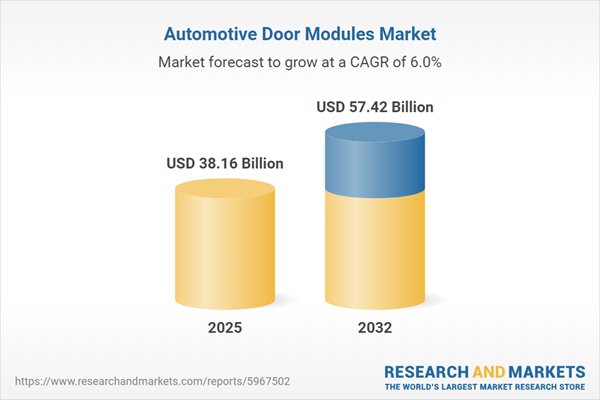Speak directly to the analyst to clarify any post sales queries you may have.
The automotive door modules market is evolving rapidly due to technological advancements and shifting policy frameworks, influencing strategies for senior executives and encouraging agility to stay competitive in a changing landscape.
Market Snapshot: Automotive Door Modules Market Growth and Opportunity
Current momentum in the automotive door modules market results from integrating digital automation, advanced sensors, and module innovation. Smart features such as electronic locking and seamless connectivity continually shape product enhancements. Rising demand from electric vehicle manufacturers and new safety requirements fuel sector growth, while differences in regional standards prompt ongoing upgrades in module design. Strategists are capitalizing on the adoption of lightweight components, unlocking new vehicle architectures and operational improvements that reinforce competitive positioning within a global market.
Scope & Segmentation: Defining Factors in Market Coverage
- Type: The market encompasses both automatic and manual door modules, affording flexibility for diverse vehicle automation and user-experience applications in fleet and consumer automobiles.
- Door Type: Modules are tailored for front, rear, and liftgate integration, enabling deployment with various body styles and across platform architectures.
- Component: Offerings span a range of solutions such as control units, integrated sensors, regulators, hinges, and latches, supporting dependable automation and consistent long-term reliability.
- Material: The use of aluminum alloys, enhanced steels, composites, and engineering plastics contributes to reduced vehicle weight and meets structural goals within door module manufacturing processes.
- End Use: Automotive door modules serve the full spectrum of commercial and passenger vehicles, providing customizable packages for heavy and light trucks as well as cars and SUVs, aligning with unique operational needs.
- Sales Channel: Distribution takes place via both original equipment manufacturers (OEMs) and aftermarket providers, accommodating diverse supply chain structures in global markets.
- Regions: The sector operates across the Americas, Europe, Middle East & Africa, and Asia-Pacific, with each zone characterized by its compliance frameworks, supplier relationships, and distinct end-user expectations.
- Companies Profiled: This analysis assesses market leaders and suppliers, including Continental AG, Infineon Technologies AG, Aisin Corporation, Beijing Jingwei HiRain Technologies, Brose Fahrzeugteile, Grupo Antolin Irausa, Cooper-Standard Holdings, EMKA Beschlagteile, Inteva Products, Kiekert, Magna International, Mitsui Kinzoku ACT, Motherson Group, Nidec Corporation, NMB Technologies, ON Semiconductor, Pektron Group, RTP Company, STMicroelectronics, Toyota Boshoku, Trinseo, WITTE Automotive, Yanfeng International Automotive Technology, Valeo, and Robert Bosch.
Key Takeaways for Senior Decision-Makers
- Adoption of next-generation door modules streamlines digital integration and supports assembly-line efficiency, boosting overall product lifecycle management.
- Focusing on recycled and hybrid materials assists sustainability targets and eases adherence to evolving global regulatory demands.
- Implementing region-specific supply chain planning ensures organizations are prepared for local regulation shifts and changing patterns in customer demand.
- Introducing advanced features, including touchless entry and embedded diagnostics, opens up new revenue channels in the aftermarket and extends customer loyalty.
- Employing flexible, modular designs enables rapid adaptation for various vehicle classes, supporting quick responses to shifting requirements and market conditions.
- Collaborating closely with partners across the supply chain and embracing vehicle electrification reduces exposure to risk and strengthens regulatory alignment.
Tariff Impact: Navigating Shifts in U.S. Trade Policy
Recent changes to U.S. tariff policies affecting automotive door modules and their components have increased focus on domestic supply chain resilience. Adjusting sourcing strategies is critical for managing costs, ensuring ongoing compliance, and maintaining steady product development during regulatory changes.
Methodology & Data Sources
This evaluation draws on insight from senior executives, technical authorities, and original equipment manufacturers. Findings are validated using regulatory analysis and peer benchmarking, resulting in pragmatic guidance for executive-level decisions.
Why This Report Matters for Industry Leaders
- Senior leaders in research, procurement, and supply chain benefit from actionable intelligence, supporting adaptive, evidence-based approaches as the market changes.
- In-depth segmentation and insights into regional dynamics enable executives to implement strategies that align with emerging policy shifts and harness new technology.
- Data-driven analysis underpins innovation, improves process efficiency, and strengthens risk oversight in increasingly complex global automotive landscapes.
Conclusion
This report delivers direction as executives seek innovation, cultivate strategic industry alliances, and pursue sustainable expansion. The analysis supports effective leadership and improved organizational agility in the automotive sector.
Additional Product Information:
- Purchase of this report includes 1 year online access with quarterly updates.
- This report can be updated on request. Please contact our Customer Experience team using the Ask a Question widget on our website.
Table of Contents
3. Executive Summary
4. Market Overview
7. Cumulative Impact of Artificial Intelligence 2025
Companies Mentioned
The companies profiled in this Automotive Door Modules market report include:- Continental AG
- Infineon Technologies AG
- Aisin Corporation
- Beijing Jingwei HiRain Technologies Co., Inc.
- Brose Fahrzeugteile SE & Co. KG
- Grupo Antolin Irausa, S.A.
- Cooper-Standard Holdings Inc
- EMKA Beschlagteile GmbH & Co KG.
- Inteva Products, LLC by Renco Group, Inc.
- Kiekert AG
- Magna International Inc.
- Mitsui Kinzoku ACT Corporation
- Motherson Group
- Nidec Corporation
- NMB Technologies Corporation by MinebeaMitsumi Group company
- ON Semiconductor Corporation
- Pektron Group Ltd.
- RTP Company by Miller Waste Mills, Inc.
- STMicroelectronics N.V.
- Toyota Boshoku Corporation
- Trinseo PLC
- WITTE Automotive GmbH
- Yanfeng International Automotive Technology Co. Ltd.
- Valeo SA
- Robert Bosch GmbH
Table Information
| Report Attribute | Details |
|---|---|
| No. of Pages | 181 |
| Published | November 2025 |
| Forecast Period | 2025 - 2032 |
| Estimated Market Value ( USD | $ 38.16 Billion |
| Forecasted Market Value ( USD | $ 57.42 Billion |
| Compound Annual Growth Rate | 5.9% |
| Regions Covered | Global |
| No. of Companies Mentioned | 26 |









